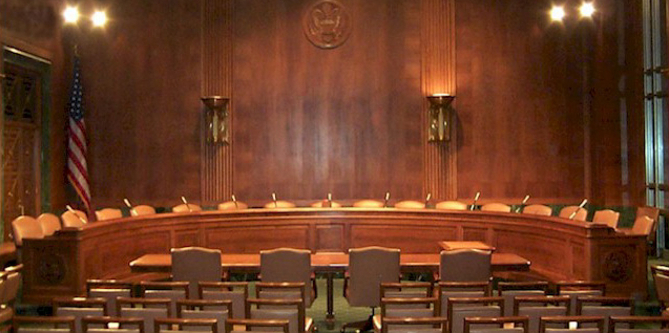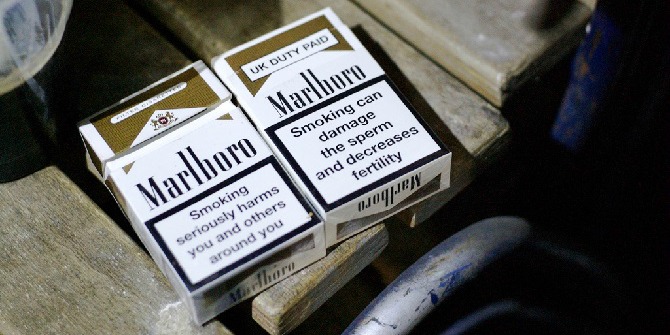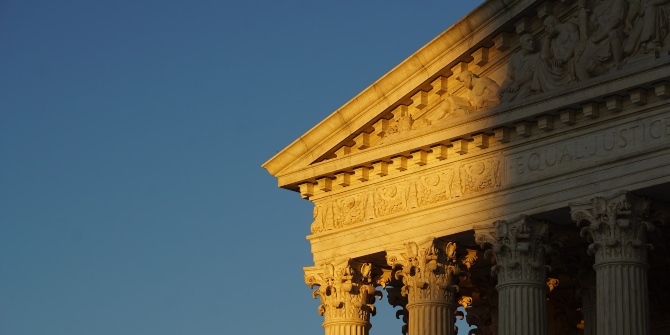 A disproportionately high number of criminal defendants are black and Latino, and yet trial juries tend to be mostly white. In new research into how juries are made up in a southeastern state, Jacinta M. Gau finds that more than 60 percent of juries were majority-white. She writes that this lack of minority representation on juries is likely down to their under representation on master lists, and other barriers such as work and childcare conflicts. According to her research, blacks, Hispanics and Asians were also more likely to be struck from the jury pool for causes such as economic or family hardship. The results also indicate that although blacks are disproportionately struck peremptorily by the prosecution, whites are disproportionately struck by the defense, and the countervailing effects neutralize each other overall.
A disproportionately high number of criminal defendants are black and Latino, and yet trial juries tend to be mostly white. In new research into how juries are made up in a southeastern state, Jacinta M. Gau finds that more than 60 percent of juries were majority-white. She writes that this lack of minority representation on juries is likely down to their under representation on master lists, and other barriers such as work and childcare conflicts. According to her research, blacks, Hispanics and Asians were also more likely to be struck from the jury pool for causes such as economic or family hardship. The results also indicate that although blacks are disproportionately struck peremptorily by the prosecution, whites are disproportionately struck by the defense, and the countervailing effects neutralize each other overall.
Criminal defendants are disproportionately black and Latino, yet trial juries tend to be majority white or even all white. This racial disconnect between juries and the defendants whose fate they decide threatens the appearance of justice. It also may imperil fairness in the administration of justice, because less-diverse juries may deliberate less and fail to consider all sides, evidence, and angles.
It is not clear why or how persons of color are either removed from the jury venire (the pool of people from which jury members are chosen) or never make it onto the venire at all. In new research, we sought to reveal some of the main sources of the lack of minorities on juries using data from a public defender’s office in a state in the southeastern US. The data are from all felony cases in 2013 and 2014 where the defendant was represented by a public defender and availed himself or herself of the right to trial by jury.
Our analyses showed clear discrepancies between the racial composition of the population and that of juries. Whites in one county constituted 50 percent of the adult population, yet 66 percent of jurors; in the other county, whites were 44 percent of the population and 60 percent of jurors. The population percentages for blacks (18 percent and 9 percent) were roughly comparable to their representation on juries (16 percent and 10 percent, respectively), but Hispanics/Latinos evinced notable underrepresentation on juries (15 percent and 28 percent) relative to their population proportions (25 percent and 43 percent, respectively). Asians suffered similar loss, down from 5 percent and 3 percent in the population to 2 percent and 1 percent of juries, respectively.
These initial percentages suggest that key sources of whitening are the institutional factors that make up the jury-selection system. Past research has shown that minorities are more residentially mobile, so master lists might be out of date and/or summons do not reliably reach them; have higher rates of wage-based jobs that do not pay workers for jury service; and experience other conflicts such as lack of transportation and childcare.
The analyses next turned to voir dire – the process by which the prosecutor and defense attorney question the members of the jury pool to determine which prospective jurors appear unsuitable for membership on the jury. The analyses attempted to discern the impact of peremptory strikes and for-cause removals on the racial composition of empaneled juries.
Results showed that whites were most likely to be struck peremptorily (35 percent of white venire-persons were removed this way), followed by blacks (30 percent), Asians (29 percent), and Hispanics/Latinos (26 percent). By contrast, racial minorities were more likely than whites to be removed for cause (28 percent of whites, 34 percent of blacks, 42 percent of Hispanics/Latinos, and 52 percent of Asians).
Further analyses of the reasons behind for-cause strikes showed that whites and blacks were most likely to be dismissed for displaying bias or partiality (78 percent and 73 percent, respectively). Clear differences emerged in the hardship category of removals: while only 21 percent of whites and 26 percent of blacks were excused due to hardship, 47 percent of Hispanics/Latinos and 46 percent of Asians were let go for this reason. As hardship includes consequences such as lost wages and problems with childcare or eldercare, it is clear in these analyses that socioeconomic barriers are not merely institutional but carry over into the voir dire process as well.
We continued on to examine the relationship between peremptory strikes across race and the party doing the striking. Some legal commentators have alleged prosecutors sometimes use peremptory strikes to prevent minorities from sitting on juries. The present analyses uncovered support for this proposition: while only 39 percent of whites struck peremptorily were struck by the prosecution, a full 61 percent of struck blacks were removed by the prosecutor. However, defense attorneys’ actions were correspondingly racialized: 61 percent of struck whites were removed by defense attorneys, as were just 39 percent of struck blacks. Hispanics/Latinos were roughly equally likely to be removed by the prosecution and defense, and Asians were more likely to be removed by the defense.
Finally, the analyses examined the prevalence of all-white and mostly-white juries. This state uses six-person juries. The figure demonstrates the percentage of juries containing each possible combination of whites and minorities.
Figures 1 – Whites’ Representation on Juries

As can be seen, most juries (62 percent) were majority white or all white. One-quarter were half white and half non-white, and on just 14 percent were whites the minority racial group. Thus, it is most likely that any given defendant appearing in this court (the majority of which are black and Latino) will be tried by juries that are all white or which contain only one or two minorities.
Results of this study suggest that institutional barriers play the most prominent role in minority attrition. For reasons probably linked to deficiencies in master lists and the socioeconomic realities facing persons of color, racial minorities are significantly underrepresented on jury venires. Those who do make it onto the venire face roughly similar chances, overall, of being selected to serve as jurors; however, hardship remains a barrier to service. There do seem to be racialized patterns in the use of peremptory strikes, but efforts by the prosecution and defense largely cancel each other out so that peremptory strikes are not, in the long run, a significant source of minority attrition. To enhance minority representation on juries, then, counties and states should pursue efforts to ensure the accuracy and inclusivity of master lists and should look for ways to reduce the financial burden of jury service on wage-based workers. Better representation of minorities on juries will improve both the appearance and the delivery of justice in criminal courts.
This article is based on the paper, “A jury of whose peers?: The impact of selection procedures on racial composition and the prevalence of majority-white juries” in the Journal of Crime and Justice.
Featured image credit: Douglas Muth (Flickr, CC-BY-SA-2.0)
Please read our comments policy before commenting.
Note: This article gives the views of the author, and not the position of USAPP – American Politics and Policy, nor the London School of Economics.
Shortened URL for this post: http://bit.ly/1RnapmX
_________________________________
 Jacinta M. Gau – University of Central Florida
Jacinta M. Gau – University of Central Florida
Jacinta M. Gau is an Associate Professor in the Department of Criminal Justice at the University of Central Florida. Her research focuses on policing, with an emphasis on race, procedural justice and police legitimacy, and police-community relations. Her work has appeared in multiple journals.






